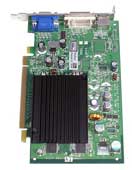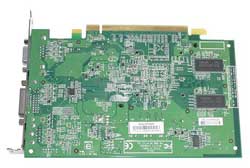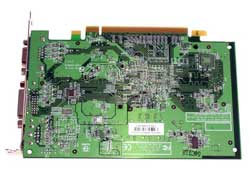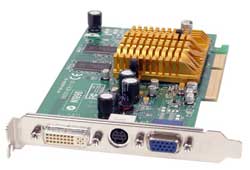Buyer's Guide - Entry Level to Mid-Range, March 2005
by Jarred Walton on March 15, 2005 1:30 PM EST- Posted in
- Guides
Video Cards
Assuming that you haven't selected one of the alternative motherboards with integrated graphics - or that you're looking for improved graphics performance - we have two different options. The socket 754 platform is currently AGP-only, although perhaps we'll see some PCIe boards using the nForce4 or a similar chipset in the future. The 939 and Intel platforms, on the other hand, are PCIe-only. (You could get a 939 AGP motherboard as well, of course.) The graphics recommendations will be different for each platform out of necessity, although we will try to keep price/performance as close as possible.AGP Graphics Recommendation:MSI Radeon 9550 128MB DDR 128-bit, 250/400 GPU/RAM clock (bulk/OEM)
Price: $67 shipped
For basic 3D graphics, the Radeon 9550 offers DirectX 9 support with enough performance to run most games that are two or three years old, and perhaps even more recent titles - at reduced quality levels. This is certainly no gamer card, but it does meet the minimum DX9 hardware requirement for the next version of Windows (Longhorn with eye candy enabled), and it will allow you to run either DVI or VGA displays along with providing TV-out support. There isn't a whole lot to differentiate the 9550 cards from one another, as they all run at similar clock speeds. We prefer the fanless varieties, of course, as they won't add any noise pollution to the room. If you can find some other brand for less money, it should be okay.
If you want more from your graphics, consider the GeForce 6200 AGP, 6600 AGP, and 6600GT AGP as the next three upgrades in order of performance. Their prices are around $100, $150, and $200 respectively, so you pay a lot more for the added performance. The Radeon 9600 (without the SE) is also a decent alternative that will only cost an extra $15. It's basically the same as the 9550 but with a faster core clockspeed (325MHz vs. 250MHz). For the price, we'd definitely stay away from the SE 9550 and 9600 cards.
 |
 |
| Click images to enlarge. | |
PCIe Graphics Recommendation: Leadtek GeForce 6200TC 64-bit, 64MB (256 shared) PCIe with 350 MHz core
Price: $71 shipped
If you missed our article on the new 6200 TurboCache cards from NVIDIA, now would be a good time to check it out. These are once again budget parts, but they manage to reduce price in an interesting way. With the added bandwidth of the PCI Express bus, the amount of graphics RAM on the cards can be reduced and system RAM can be used instead, all without seriously degrading performance. 16MB and 32MB versions can utilize up to 128MB of system RAM, and 64MB versions can use up to 256MB of system RAM. As with the 9550, the total performance level is still relatively low, but the 6200TC-32 is generally slightly faster than the 9600SE and X300SE while the 6200TC-64 is faster than the 9600/X300.
 |
 |
| Click images to enlarge. (Sample images of 16MB 16-bit 6200TC.) |
|
The TurboCache cards are available with either 32-bit or 64-bit memory interfaces, with core clock speeds ranging between 300 MHz and 350 MHz. The best price/performance is the 32MB 64-bit version, which is only slightly more expensive than the 16MB version. Look closely at what is being sold, however, as not all manufacturers or resellers are entirely clear on the specifications of the product being sold. If you can find some good pictures of the card, the presence of four RAM chips - two on each side - indicates that the card is a 64MB, 64-bit version. Two chips means that it's the 32MB, 32-bit model, and a single chip indicates that it's the low-end 16MB, 32-bit model. The full 128MB cards with 128-bit interfaces will have eight chips. To help you understand the differences, we have included two shots of the 6200TC-64 Leadtek card (front and back views) above. Compare that with the following images of a 6200TC-16 Leadtek card, and you can see the missing RAM chips.
PCIe Graphics Alternative:Leadtek GeForce 6600 128-bit, 128MB PCIe 300/550 MHz GPU/RAM
Price: $109 shipped
The full 6200 with 128-bit memory interface is the best of the "value" graphics chips, but with a price hovering just over $ 100, it's a pretty big jump. The better value at that range - at least for PCI Express - is to go with the 6600 chipset. It's supposed to be a "mid-range" part, and MSRP was initially $150, but the price has dropped quite a bit now. As most graphics chips are bandwidth limited with these cards, the jump from a 64-bit interface to a 128-bit interface improves performance quite a lot, particularly as resolutions increase. (If you're going with an AGP configuration, 6600 cards cost quite a bit more, so the 6200 128-bit is the better pick.) Overall performance of the 128-bit cards is generally better than the 9600 Pro cards of previous Guides, although not by a huge margin.
It is interesting to note that the current street prices on all the 6200 cards are quite a bit lower than the original estimates that we received from NVIDIA. The upgrade from the 16MB to 32MB cards is virtually free, with even the 64MB cards costing less than the original 6200 128MB cards. That's a good thing in our book, especially considering that the original 128-bit 6200 card is still the fastest of the bunch. For further performance increases, you'll need to look to the 6600 and 6600GT cards, just like on the AGP platform. If the X800 cards from ATI start to hit the $199 MSRP, that would also be a great option, albeit firmly in the mid-range price segment.
Update: Thanks to the reader comments for reminding us that the 9550 128-bit is a better choice than the 9600SE. The decreased GPU speed is typically less important than the increased memory bandwidth at this price point. They also pointed out the price drop on the 6600 PCIe cards, making them a better selection than the 6200 as an alternative. However, we still like the Gigabyte 6200 card initially listed as the alternative recommendation due to the inclusion of component output. If gaming isn't a concern but component output is, you might want to go with that instead of the 6600.












59 Comments
View All Comments
JarredWalton - Tuesday, March 15, 2005 - link
17 - The older Maxtor are like the older WD: they use standard bearings and are prone to develop a whine (in my experience). If you can verify that the drive has fluid dynamic bearings, you could get Maxtor as well. I haven't had great experiences with the Maxtor drives, although I've heard the latest models are better.JarredWalton - Tuesday, March 15, 2005 - link
15 - Sorry, I meant "9550" but typed "5500". The article lists the correct card, though. :o Most of the FX cards aren't worth consideration.As for the 6200TC, there are actually 3 versions, all of which were tested in the AnandTech article. There is a 16MB 16-bit card (one RAM chip), a 32MB 32-bit card (two RAM chips), and a 64MB 64-bit card (four RAM chips). The 32MB cards are not a 64-bit interface as far as I am aware. Many companies are causing confusion on the TC cards as they'll count the PCIe connection as bandwidth in order to make the features look better. Even if the RAM were 700 MHz instead of 550 MHz, you're looking at 2800 MBps on-card bandwidth for the 32-bit version vs. 4400 MBps on the 64-bit version. In theory, the PCIe connection will add an additional 2000 MBps (roughly - 2000 up and 2000 down) , but some of the RAM bandwidth is going to the CPU.
16 - I'd take the guaranteed 6600 for $7 more over the 6200. The 6200 also lacks support for certain memory compression schemes as I understand it.
Klober - Tuesday, March 15, 2005 - link
I know this is a minor point, but I'm curious as to why Maxtor isn't mentioned in the price guide for hard drives. Is there something I don't know about them concerning speed, noise or reliability?filterxg - Tuesday, March 15, 2005 - link
To most people I'd continue to recommend a 6200 over a 6600 vanilla. Rivatuner unlocks the 4 pipelines (softmod), so it becomes an indentical card.Jep4444 - Tuesday, March 15, 2005 - link
"Oh, as far as the budget PCIe card recommendation going to the 64MB 6200TC, please read the benchmarks in our 6200TC article before saying that the 32MB/32-bit version is better (due to memory speeds)."you seem to be confusing cards, i'm talking about the 32MB/64bit part thats clocked at 700mhz(as opposed to 550mhz of the 64MB one)
you're thinking of the 16MB version thats 32bit
PS who said to use the 5500? he mentioned the 9550 which is faster than the 5500
JarredWalton - Tuesday, March 15, 2005 - link
13 - Regarding refurb, that's something for the individual to decide. Warranty and availability are limited, so we don't recommend them in Guides. I still don't know about the Chaintech, as I can't find concrete information on specs for the Ultra vs. standard. According to Chaintech, it's the standard nF4 vs. the Ultra, which means the only thing that gets lost is SATA-2 support and a few network "enhancements". They're the same chipset with different resistors cut.Fricardo - Tuesday, March 15, 2005 - link
Same as those above, I'd say go with a 6600 non-gt for the upgraded setup. If you're actually going to upgrade the vid-card -- indicating you care somewhat about gaming -- you might as well do it right and spend the extra $7.Is it worth the $10 savings to go from the Ultra mobo to the vanilla? I don't know but I've heard that chipset wasn't made to OC well. Seems like you'd get a bit more value and $99 is still a great price for a mobo. I'm just wondering.
Another possibility for reducing cost is refurbed parts. I've been looking through NewEgg's refurb video section lately and there's tons of great cards for cheap. PCI-Express too. It seems to me you can really raise value that way.
JarredWalton - Tuesday, March 15, 2005 - link
Oh, as far as the budget PCIe card recommendation going to the 64MB 6200TC, please read the benchmarks in our 6200TC article before saying that the 32MB/32-bit version is better (due to memory speeds). The bump from 32-bit to 64-bit more than makes up for the slower RAM (if it is indeed slower). The 64MB 6200TC also beats the X300 in *every* test, so there's no reason to go with the X300 card unless you insist on ATI.http://www.anandtech.com/video/showdoc.aspx?i=2300...
I'm actually not fully convinced the "TurboCache" architecture really works all that well. Looking at the various cards, the performance scales almost directly with local memory bandwidth. But that's a topic for another day.
JarredWalton - Tuesday, March 15, 2005 - link
Oops... some bad picks on the GPUs this time. I keep forgetting the 5500. I have updated the GPU page with new picks, and will shortly update the summaries. I guess after seeing 6600 AGP prices I forgot that the PCIe cards were substantially less. Sorry.I also corrected the VNF4 to omit the Ultra. I can't tell if the Ultra includes Firewire support or not. Newegg, at least, is using the same images for both models. I think that's what threw me off in the first place.
rivethead - Tuesday, March 15, 2005 - link
Sorry about my post #7. I just re-read it and I wasn't very clear.What I was trying to say is that I think you're wanting to recommend the Chaintech VNF4 mother board (currently $89 shipped from newegg). This board is different than the Chaintech VNF4/Ultra which is about $100 shipped. For the extra $11, you get a motherboard powered by the nvidia nForce 4 Ultra chip which includes onboard firewall, SATA2 support, and nvidia nTune performance software.
For me, I think the extra $11 is worth the features.
I beleive you'll need to either change the price or alter the narrative to be clearer on your board selection.
But if you really can find the Chaintech VNF4/Ultra for $89 please let me know where!